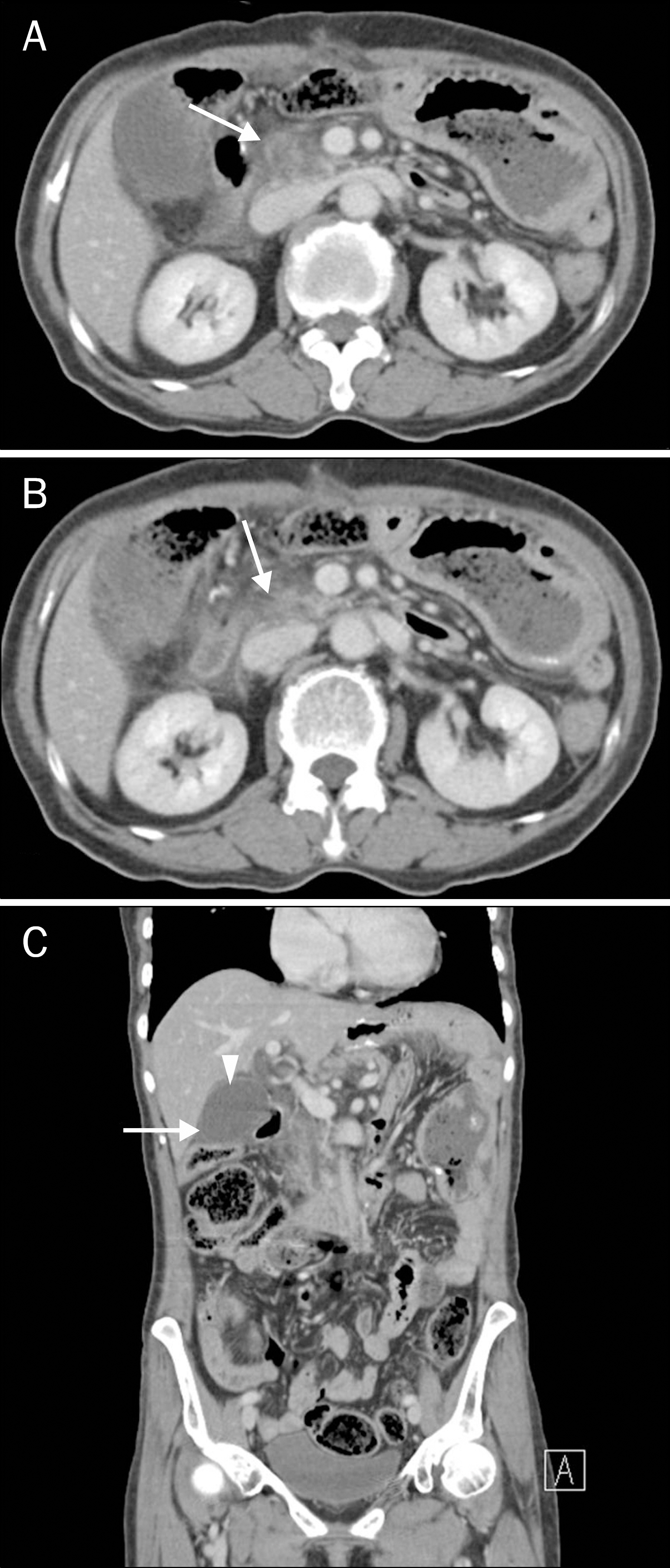Korean J Gastroenterol.
2013 Nov;62(5):306-309. 10.4166/kjg.2013.62.5.306.
A Case of Acute Pancreatitis and Acute Hepatitis Caused by Ingestion of Ceramium kondoi
- Affiliations
-
- 1Department of Internal Medicine, Jeju National University School of Medicine, Jeju, Korea. choyk1120@hanmail.net
- 2Department of Medicine, Jeju National University School of Medicine, Jeju, Korea.
- KMID: 1775740
- DOI: http://doi.org/10.4166/kjg.2013.62.5.306
Abstract
- In Korea, the use of herbal remedies is a common cause of drug-induced liver injury. However, the occurrence of both acute pancreatitis and acute hepatitis after taking herbal remedies has rarely been reported. Herein, we report a case of concurrent acute pancreatitis and acute hepatitis associated with Ceramium kondoi ingestion. A 58-year-old woman was diagnosed with advanced gastric cancer 7 months ago. Total gastrectomy and adjuvant chemotherapy was performed without complications. The patient had been well until recently, when she presented with severe abdominal pain after ingestion of Ceramium kondoi for 4 weeks. The laboratory findings demonstrated elevated liver enzymes and lipase, and abdominal computed tomography revealed pancreas swelling with fat infiltration. The diagnosis was made based on the diagnostic criteria for drug induced pancreatitis and the Russel Uclaf Causality Assessment Method scale for drug-induced liver injury. After cessation of Ceramium kondoi, she showed clinical and biochemical improvement.
MeSH Terms
-
Abdominal Pain/etiology
Acute Disease
Drug-Induced Liver Injury/*diagnosis/enzymology
Female
Humans
Lipase/metabolism
Liver/*drug effects
Middle Aged
Pancreas/*drug effects
Pancreatitis/*chemically induced/*diagnosis
Plant Extracts/chemistry/*toxicity
Rhodophyta/chemistry/metabolism
Tomography, X-Ray Computed
Lipase
Plant Extracts
Figure
Reference
-
References
1. Navarro VJ, Senior JR. Drug-related hepatotoxicity. N Engl J Med. 2006; 354:731–739.
Article2. Bénichou C. Criteria of drug-induced liver disorders. Report of an international consensus meeting. J Hepatol. 1990; 11:272–276.3. Kim DJ. The assessment of toxic liver injury. Korean J Gastroenterol. 2009; 53:5–14.4. Lankisch PG, Dröge M, Gottesleben F. Drug induced acute pancreatitis: incidence and severity. Gut. 1995; 37:565–567.
Article5. Trivedi CD, Pitchumoni CS. Drug-induced pancreatitis: an update. J Clin Gastroenterol. 2005; 39:709–716.6. Wargo KA, Allman E, Ibrahim F. A possible case of saw palmetto-induced pancreatitis. South Med J. 2010; 103:683–685.
Article7. Jibrin I, Erinle A, Saidi A, Aliyu ZY. Saw palmetto-induced pancreatitis. South Med J. 2006; 99:611–612.
Article8. Baek JT, Kim MS, Kang SB, et al. Etiology of acute hepatitis for the last 5 years in Daejeon. Korean J Intern Med. 1999; 57(Suppl):S352.9. Lim JH, Kim YS, Lee YN, et al. Clinical characteristics and pathological findings in patients with toxic hepatitis. Korean J Med. 2011; 81:53–63.10. Nitsche CJ, Jamieson N, Lerch MM, Mayerle JV. Drug induced pancreatitis. Best Pract Res Clin Gastroenterol. 2010; 24:143–155.
Article11. Vinklerová I, Procházka M, Procházka V, Urbánek K. Incidence, severity, and etiology of drug-induced acute pancreatitis. Dig Dis Sci. 2010; 55:2977–2981.
Article12. Kaurich T. Drug-induced acute pancreatitis. Proc (Bayl Univ Med Cent). 2008; 21:77–81.
Article13. Klein SM, Khan MA. Hepatitis, toxic epidermal necrolysis and pancreatitis in association with sulindac therapy. J Rheumatol. 1983; 10:512–513.14. Kang JW. Illustrated encyclopedia of fauna & flora of Korea. Vol. 8, Marine algae. Seoul: Samhwa;1968.
- Full Text Links
- Actions
-
Cited
- CITED
-
- Close
- Share
- Similar articles
-
- Acute Pancreatitis associated with Acute Hepatitis A in an Old Aged Patient
- Acute Pancreatitis Complicating Spontaneous Acute Exacerbation of Chronic Hepatitis B Virus Infection: Case Report and Review of the Literature
- A Case Report of Acute Pancreatitis Caused by Mycoplasma Pneumoniae Infection
- A Case of Acute Pancreatitis in Acute Hepatitis A Infection
- Multiple complications associated with hepatitis A in a pregnant woman


